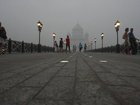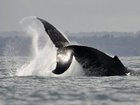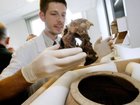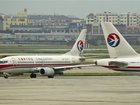Street lights have an unexpectedly strong effect on insect populations, favoring some species while punishing others, according to a study released Wednesday that raises new questions about human impact on wildlife.
Researchers led by Thomas Davies at the University of Exeter, southwestern England, spent three days in August 2011 placing insect traps around Helston, a small town in Cornwall.
 Full Story
Full Story
Biologists on Wednesday reported they had discovered a new sensory organ on blue, humpback, minke and fin whales that helps explain why these mammals are so huge.
In a study appearing in the journal Nature, researchers in the United States and Canada said the organ is located at the tip of the whale's chin, in a niche of fibrous tissue that connects the lower jaw bones.
 Full Story
Full Story
The French media like to call him the "Indiana Jones of the graveyards", but perhaps a better tag would be the Sherlock Holmes of forensic science.
With powerful microscopes and hi-tech diagnostics that tease out chemical signatures and DNA telltales, pathologist Philippe Charlier pores over centuries-old remains to probe the riddles of history.
 Full Story
Full Story
Opening a new, entrepreneurial era in spaceflight, a ship built by a billionaire businessman sped toward the International Space Station with a load of groceries and other supplies after a spectacular middle-of-the-night blastoff.
The launch of the Falcon 9 rocket and its unmanned Dragon capsule marked the first time a commercial spacecraft has been sent to the orbiting outpost.
 Full Story
Full Story
A European envoy held out a possible compromise in a fight with China over carbon emissions charges on airlines, saying Wednesday that Europe might alter its system if Beijing helps negotiate global regulations.
China, India, the United States and Russia oppose the European Union charges that took effect Jan. 1. Beijing has barred its carriers from cooperating and has suspended purchases of European aircraft.
 Full Story
Full Story
Taiwan has begun testing DNA from shark fins sold in local markets in a bid to protect endangered species such as great whites and whale sharks, an official from the Fisheries Agency said Wednesday.
The efforts come as the island moves to restrict its shark-fin industry, which environmental groups say accounts for the deaths of 73 million sharks each year across the world.
 Full Story
Full Story
An "unprecedented" surge in debris from last year's Japanese tsunami is washing up on Alaska's coastline, environmentalists about to embark on a major cleanup operation said Tuesday.
Floating material including buoys and Styrofoam has washed up on Montague Island, some 120 miles (190 kilometers) southeast of Anchorage, in volumes that clearly suggest a wave of debris from the March 11, 2011 killer tidal wave.
 Full Story
Full Story
A powerful solar telescope billed as the largest in Europe opened Monday on Spain's Canary Islands which scientists say will allow them to study the sun in unprecedented detail.
With a mirror diameter of 1.5 meters (4.9 feet), the Gregor telescope will be able to show structures on the sun on scales as small as 70 kilometers (43.5 miles), the Astrophysical Institute of the Canary Islands said in a statement.
 Full Story
Full Story
Just as wealth and social status are often linked to good health in humans, the animal kingdom too has its benefits for those at the top of the hierarchy, according to a U.S. study out Monday.
After studying 27 years worth of data on baboons in Kenya, researchers found that alpha males were less likely to get sick and recovered faster from injuries than those at the lower rungs of society.
 Full Story
Full Story
When pregnant rats are exposed to a common crop chemical, their descendants three generations later show more anxiety and stress than the offspring of unexposed peers, U.S. researchers said Monday.
The study in the Proceedings of the National Academy of Sciences suggests that the animal model may provide an explanation for the mounting number of cases of anxiety disorders, autism and obesity among humans in recent years.
 Full Story
Full Story



